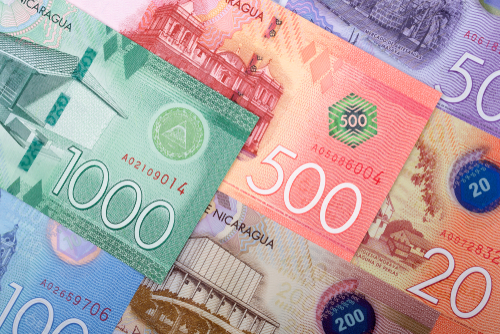If you’re planning to visit Nicaragua or relocate there, understanding the national currency is essential. This guide will introduce you to the Nicaraguan cordoba (NIO), its history, current exchange rates, and tips for using the local currency effectively. With practical advice and key insights, you’ll feel confident managing your finances during your time in this beautiful country.
What Is the Nicaraguan Cordoba?
The official currency of Nicaragua is the cordoba (C$), named after Francisco Hernández de Córdoba, a key historical figure in the country’s colonial past. One cordoba is subdivided into 100 centavos, making it a straightforward currency to use for everyday transactions.
The Banco Central de Nicaragua (CBN) oversees the issuance of banknotes and coins, ensuring the currency’s reliability and stability. On the global exchange market, the cordoba is represented by the currency code “NIO,” and prices are commonly written with “C$” preceding the value (e.g., C$100).
Banknotes in Circulation
Nicaragua’s vibrant banknotes are not only functional but also reflect the country’s rich history and culture. Here’s a rundown of the current notes in circulation as of May 2023:
- C$10: A green polymer bill featuring Puerto Salvador Allende on Lake Managua and a folk dance on the reverse.
- C$20: An orange polymer bill showcasing the Moravian Church and the Palo de Mayo folk dance. A sea turtle appears in the security window.
- C$50: A purple polymer bill depicting Masaya craft market and the Ballet Folklorico dance.
- C$100: A blue polymer bill featuring Granada Cathedral and a traditional horse carriage.
- C$200: A red polymer bill with imagery of the Rubén Darío National Theater and the El Güegüense satirical play.
- C$500: A red bill showcasing León Cathedral and the iconic Momotombo Volcano.
- C$1000: A dark green bill displaying Hacienda San Jacinto and the Castle of the Immaculate Conception.
Coins in Circulation
Nicaragua also uses coins, ranging from small denominations to functional equivalents for everyday purchases:
- Centavos: 5, 10, 25, and 50 centavos coins made from various metal alloys.
- Cordobas: C$1, C$5, and C$10 coins, each with detailed imagery like Andrés Castro Estrada or symbolic patterns.
A Brief History of the Cordoba
The Nicaraguan cordoba has over a century of history. Originally, Spanish coins dominated trade in the region during the colonial era. After its independence, Nicaragua struggled without a national currency and introduced its first system based on the peso in the late 19th century.
The cordoba was officially adopted in 1912, named to honor the country’s colonial founder, and the modern version underwent improvements during periods of inflation. The most recent polymer banknotes, released in 2015 and further updated in 2019, have made the cordoba both vibrant and secure.
The intricate design and cultural imagery featured on these notes have garnered international recognition, including honors like the 2016 Regional Banknote of the Year Award.
Exchange Rates and Currency Conversion
Exchange rates between the cordoba and other currencies, like the U.S. dollar (USD), fluctuate based on market conditions. As of May 2023, the approximate rate was 1 cordoba to USD $0.027, meaning one cordoba was worth about 2 cents in U.S. currency.
Tips for Currency Conversion
- Compare Providers: Check rates at banks, exchange offices, and online money transfer apps to find the most favorable deals.
- Use Trusted Online Services: Apps like Remitly allow you to send U.S. dollars or convert USD to NIO securely.
- Monitor Fluctuations: Exchange rates can vary daily, so plan your transactions accordingly.
5 Essential Facts About Money in Nicaragua
Here are key points to help you manage currency during your time in Nicaragua.
1. U.S. Dollars Are Widely Accepted
While the cordoba is Nicaragua’s official currency, USD is often accepted in major cities and tourist areas. However, smaller businesses and rural areas typically require payment in cordobas, so carrying both currencies is recommended.
2. ATMs Are Convenient for Cash Withdrawals
Most cities in Nicaragua have ATMs that dispense cordobas or U.S. dollars. Look for well-lit, secure locations, especially if withdrawing cash after dark.
3. Currency Exchange Requires Care
Only exchange money through authorized services to avoid counterfeit notes or unfavorable rates. Banks and formal exchanges located inside financial institutions are the safest options.
4. Credit and Debit Cards Are Widely Used
Visa and Mastercard are accepted at many hotels, restaurants, and shops in major cities. Be aware of international transaction fees, and notify your bank of your travel plans to avoid disruptions.
5. Coins Are Useful for Small Purchases
Carry a mix of coins and lower-denomination notes for small transactions, like paying for local transportation or snacks at markets.
Frequently Asked Questions
What is the best way to secure local currency in Nicaragua?
Using ATMs in safe locations is often the most reliable way. Alternatively, exchanging small amounts of USD at authorized exchange counters provides flexibility.
Can I use other international currencies besides USD?
USD is the only widely accepted foreign currency in Nicaragua. Convert other currencies, like euros or pounds, to USD before arrival.
How can I verify the authenticity of cordoba banknotes?
Familiarize yourself with the unique features of Nicaraguan notes, such as the security windows and polymer texture. Avoid accepting old, worn notes from unauthorized money changers.
Are there transaction fees in Nicaragua for foreign cards?
Yes, most banks charge international transaction fees for withdrawing money or making purchases. Check with your financial institution for specific rates.
Where can I send money to Nicaragua securely?
Remitly offers a safe and efficient way to send money to loved ones in Nicaragua, with transparent fees and real-time tracking.

